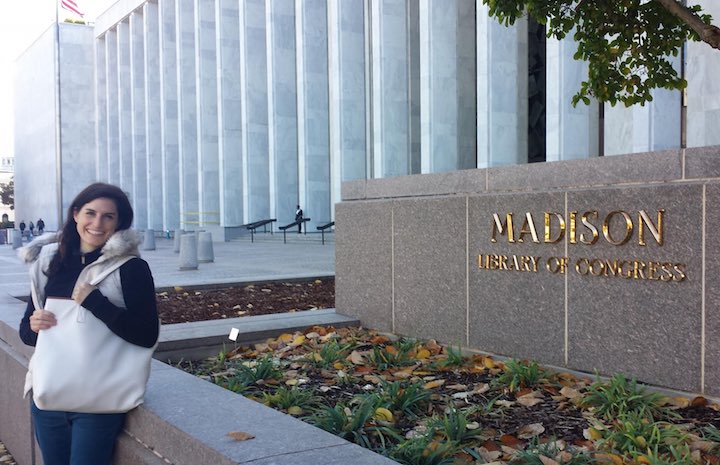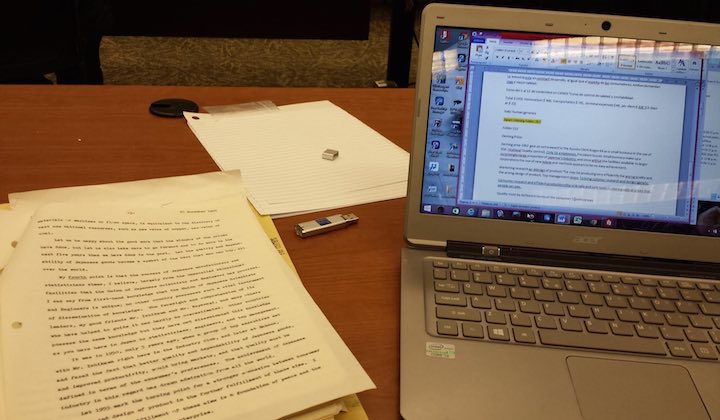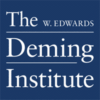Guest post by Luciana Paulise. See her previous guest posts: Applying Deming Principles at Small and Medium-sized Enterprises and Applying a Model for Small Business Continual Improvement.
W. Edwards Deming used to say “Knowledge is the key. Lack of knowledge…that is the problem.” Knowledge is what differentiates successful companies from the ones that are not. And helping people to get knowledge is a wonderful gift only some dare to give. The Deming Institute gave me the opportunity to get to know more about Deming and his System of profound knowledge through a grants they awarded me. I was fortunate enough to get one of the 5 annual grants to be able to access to the Deming Collection at the Manuscript Division of the Library of Congress in Washington, D.C. The manuscripts division was established in 1897, and includes historical documentation, including 23 groups of presidential papers, ranging in time from George Washington to Calvin Coolidge, an inspiring place indeed.

- Plan: I was so excited to continue my research directly at the Library of Congress that I couldn’t wait to travel from Buenos Aires to Washington D.C., but first I needed to plan ahead the content I was going to request access to.
- Get a contact or advisor: All researchers are advised to email or telephone the Manuscript Reading Room prior to visiting. Many collections are stored off-site, and advance notice is needed to retrieve these items for research use. The division provides reference service in person or by correspondence. I actually sent them an email to request the folders I was going to look at to avoid any delays when I finally got to the library. This assistance is generally provided by professional reference librarians in the reading room.
- Divide and conquer: Considering that I was only going to be there 5 working days, I requested 15 boxes, and tried to allocate a specific amount of time per folder. What happens is that Parkinson’s Law states that work will expand to fill the time given for it to be executed, so if you are not prepared about how to get your work done, you may not be able to finish on time, and delaying my trip back was not an option for me.
- Focus on the important stuff: Bill Bellows from The W. Edwards Deming Institute, who had already been to the library in 2003 suggested not to read every page carefully at the reading room, but try to identify the important pages and make as many copies as possible to read everything carefully once at home, that way I would be able get the most out of the library in a short period of time. That was a great advice, which I strongly recommend to follow. Readers may purchase photocopies, photographs, or microfilm of manuscripts through the Library’s Photoduplication Service. The library provides access to two high-resolution overhead scanners in the reading room, free of charge, but you should bring your own USB storage device, such as a flash drive, if you wish to use them. Xerox machines are available with a cost of 20¢ per page. I even used my cellphone to take pictures of some of the pages to make it faster. I would just write some phrases or bullets to remember relevant information for my research.
- Bring identification: When you arrive at the Library of Congress, and if you have not used the Library’s reading rooms within the last two years, you need to first visit the reader’s registration office in the Madison Building (LM-140) to obtain or update your library identification card. A valid photographic identification is required for this process, such as a driver’s license or passport.
- Bring your laptop and a camera, top. The Manuscript Reading Room is located in room LM-101 of the Library’s James Madison Memorial Building. The room is open Monday through Saturday from 8:30 a.m. to 5:00 p.m. the building also has a wonderful floor for having breakfast or lunch in case you would like to stay all day reading, as you cannot drink or at the reading room. Once you have your identification card you can go to the reading room, where you will get Access to free lockers is provided to secure personal items. No personal belongings, including briefcases, notebooks, books, folders, envelopes, purses, or hats are allowed in the reading room, you can only enter with your computer, cellphone (just to take pictures), a flash drive and the key to the locker. At the front desk you would fill a card with the folders to read that day, and then you can go to the table you like, and the librarians will take your folders there.

- Have a clear objective in mind: The manuscripts were wonderful. The folders included handwritten material as well as pictures and some booklets. It was fascinating to read some of the letters Deming would write to Noriaki Kano, or to Ford’s CEO Donald Petersen, and a bit of his work at various other companies. His clients were so diverse, from telecommunication companies to railway and automotive enterprises, even hospitals.
I also could access some of his conference speeches, for example he would usually speak at the annual award of the Deming Prize in Japan. There was so much wonderful information that I could stay reading forever, time really passed by fast down there. If you have a clear objective in mind, it is easier to be able to focus your time on the important, you will probably want to take pictures of every single note, but you will probably not be able to read everything when you are back home.
You will also find that some folders don’t have the information you were expecting, some are too small and some are too full of data. So just in case request a broad list of folders but try to stick to your initial plan and only adjust if you have extra time. If you are there for a week (as I was), you can request for extra boxes while you are in the library, I actually requested a couple more during the first two days, as some information was split into different boxes. In order to get the grant I had to prepare a research plan, which helped me a lot to organize my thoughts before, during and after the library.
Going to the Annual Deming Institute Conference and then to the library was just perfect. When I got to the library I was really focused on the subject and had lots of more questions than before. The research time after the library was also very much fulfilling to me, reading the material again but more carefully and writing a summary about it took me some months after the trip, but it paid off. I will be publishing a book about my research in April 2016.
I never stopped reading about Deming, I got engaged with the Deming Collaboration, a group to discuss about his teachings in weekly online meetings, with fans from all around the world: Argentina, Brazil, Thailand, England, US, you name it. I also keep reading the The W. Edwards Deming Institute blog, watching the new videos uploaded, and listening to the podcasts. What are you doing to keep yourself up to date on Deming concepts?
Luciana Paulise is a business consultant and founder of Biztorming Training & Consulting. She holds a Master in Business Administration and is also a Quality Engineer certified by the American Society of Quality (ASQ). She has participated as an examiner for the National Quality Award in Argentina. Participates in weekly meetings with the Deming Collaboration Group. She is also a columnist for Somos PYMES (Argentina) Destino Negocio (Spain), Influential Voice for the ASQ (US) and for SimpliLearn (India). Speaker and author.
In 2014, Luciana received a grant from the Deming Institute to develop the SME (small and medium size enterprise) deck based on Deming teachings.



Wonderful story, wonderful reading. Thank you for sharing with us your interest in Mr Deming and his gifts to the world. Largely forgotten now, I’ll never how awestruck I was when I was a young man and read his story and works for the first time. I’m almost seventy years old now but I remember it like yesterday and I it helped me so much in the twenty five years I spent working with the people of Mexico in a maquiladora factory. Some of the best years of my life.
Warmest regards,
Bryan L Oglesby